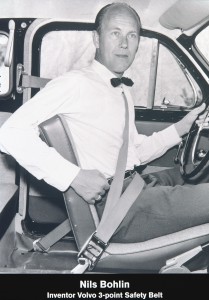Volvo hardly deserves all the credit for its admirable frosting on the safety cake. Thursday, August 13, 2009 marks the 50th anniversary of Volvo obtaining a patent, presumably in Sweden, for the three-point safety belt it pioneered.
But they’ve gone overboard in patting themselves on the back for the advance in safety engineering. Perhaps this is because they have a narrow European, even Scandinavian, viewpoint. In any event, Volvo’s lengthy European press release on their pioneering role in three-point belts almost completely ignores the American experience.
Furthermore, Volvo credits the three-point belt with “saving an estimated million lives worldwide.” That may or may not be true, and probably there is no way to prove it one way or the other, for the simple reason that few fatal accident investigators, usually state police, have the ability to decide whether a two-point belt would have been just as effective, especially in ejection-from-the-vehicle incidents. Moreover, with crashes in more modern cars, how could one distinguish between the safety contributions of the three-point belt versus that of an air bag?
If Volvo’s perhaps naïve ploy is successful, you’ll no doubt see lots of stories in the Mainstream Media touting Volvo safety, written or screened by equally naïve, under-informed journalists. So let me give you the American background.
As my newest book, Detroit Area Test Tracks, (due to be released by Arcadia in January—pardon the plug) documents, Detroit automakers were doing safety testing, mainly rollovers, in the early 1930s. What was lacking were safety statistics that could lead them in the direction of doing the most good. The systematic, scientific study of fatalities in auto crashes didn’t come until the early 1950s.
Elmer Paul, an Indiana State Police sergeant, noticed that many of the fatals he handled didn’t involve serious damage to the cars, yet people were dead. So he began collecting statistics, which rather quickly demonstrated the major cause of fatal injuries was ejection from the vehicle, usually in a rollover. Secondarily, occupants were slamming against the car interior when it abruptly stopped in a collision and, being unrestrained, the occupants kept moving. I can recall, as a pre-schooler in the 1930s, standing on the front seat while my mother drove the family V-8. This was typical of the times. Even caring parents simply had no notion of the dangers.
Sgt. Paul took his information to the Cornell Aeronautical Research Lab, which had been dealing with aviation safety, and the Lab folks then contacted the automakers. This lead to a new type of safety testing, controlled barrier crashes as well as rollovers. Today this sounds simple enough, but at the time it required a lot of engineering test development aimed at scientific repeatability.
The result was Ford’s 1956 model “safety package” consisting of standard improved door locks and latches and deep-dish “collapsible” steering wheels, plus optional front-seat lap belts and padded dash. Other automakers either paralleled Ford or quickly followed. However, members of the buying public were hardly enthusiastic in their response.
Nevertheless, for the next decade and a half, before shoulder belts in addition to lap belts were mandated as standard by the Federal government, interior designs were predicated on lap-belted front occupants. This meant recessed and “crushable” instrument panels and modifications to instrument knobs.
Later, about 30 years ago, the Feds mandated the Volvo-like three-point belt as clearly superior to lap-belt only if for no other reason than it spread the load of a high impact over the torso.
Actually Detroit began installing safety equipment such as standard laminated “shatterproof” windshields in its cars as early as 1927. Chrysler products had “safety–rim” wheels that helped keep tires from separating in the event of a blowout; pre-war Chrysler cars also featured “safety-warning” speedometers which changed color from green to yellow to red as speed increased. A couple of post-WWII cars, Nash in particular, had aircraft-like seat belts “for comfort.” My father’s 1950 Chrysler Windsor sported an attractive padded dash and swept-away panel.
As a newspaper reporter covering, among other things, fatal car crashes in the mid-1950s, I became a believer in seat belts. My later cars, including “previously-owned” beaters, were equipped with belts once they became available on the aftermarket. Public service organizations like the Jaycees offered seat-belt installation kits and installations.
So Volvo hardly deserves all the credit for its admirable frosting on the safety cake.


Whoever gets the glory, seatbelts remain to be the single most important safety feature on all modern cars. The last few decades saw the evolution of the seatbelt, from the lap-belt to the 3-point variety. It’s great that it was mandated; the Volvo-like three-point belt is clearly superior to a lap-belt in that it spreads the load of a high impact over the body. Thanks for the post
You’ve taken the words right out of my mouth.